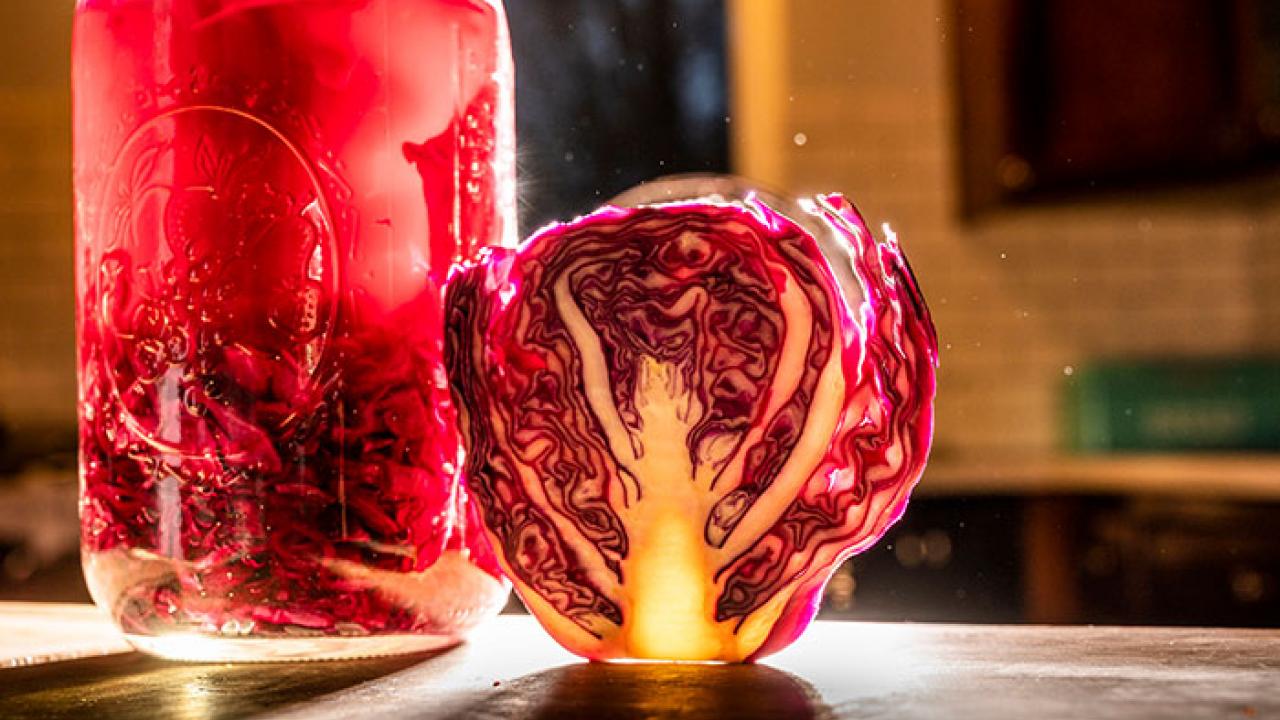
The Lowdown on Home Food Fermentation
6 Tips for Home Food Fermentation
6 Tips for Home Food Fermentation
In California, fermented foods and beverages are especially trending with young people, and food safety specialist Erin DiCaprio said information is in demand.
“I get calls every day from people asking things like, ‘There’s a white film on top of my sauerkraut. Is it still safe to eat?’” DiCaprio said.
DiCaprio is working with the UC Master Food Preserver Program to teach classes on fermentation and to provide information on how to safely ferment foods at home.
Here are DiCaprio’s top tips:
- Follow a research-based recipe, like the ones you can find at UC Food Safety, the USDA Complete Guide to Canning and the National Center for Home Food Preservation. “Some of the resources available online and in print haven’t been vetted for safety,” DiCaprio said. “They might not have you add enough salt in the beginning, for example, which is important for keeping your product from spoiling.”
- Sanitation matters: Keep hands, equipment and the preparation area clean and sterile throughout the fermentation process.
- Start with good, fresh ingredients.
- Control temperature: Don’t let your ingredients get too hot or too cold.
- Monitor the process to make sure it’s fermenting properly—that little bubbles are slowly rising to the surface, for example, and that mold isn’t growing throughout the container. “You can’t just set something on a counter and forget about it,” DiCaprio noted.
- Skim the scum. It’s common for a layer of yeast and mold to form atop your vegetable brine after a few days. DiCaprio recommends skimming it off each day. So that white film on top of your sauerkraut? It’s probably OK.
The ancient art of fermentation is America’s latest food trend, celebrated at five-star restaurants, prepared in home kitchens and touted for healing everything from obesity to cancer.
Are the health benefits real? Are there food-safety precautions people should consider when fermenting food at home? Food scientists at the UC Davis are addressing those questions and more.
“With fermentation, everything old is new again,” said Maria Marco, a microbiologist and food science professor. Marco and Erin DiCaprio, a food safety expert and Cooperative Extension specialist, recently received a $213,000 grant from the U.S. Department of Agriculture to expand the science and education of fermented fruits and vegetables. Their work will help consumers, cooks, food processers and others safely prepare fermented foods and understand the role fermentation can play in healthy diets.
Managing microbes
Fermented foods and beverages are produced by nurturing conditions that discourage the growth of harmful bacteria and encourage the growth of beneficial microorganisms. Take sauerkraut, for example. When you combine cabbage, salt, time and the right temperatures, you can help friendly microbes flourish. As they do, they convert sugars in the cabbage into lactic acid that produces tangy flavor compounds and keeps harmful bacteria at bay.
Similar chemistry is at work when producing a long list of fermented foods, such as yogurt, cheese, bread, alcohol, chocolate, coffee, salami, vinegar, kimchi, miso, tempeh and pozol.
In addition to adding new flavors and textures, fermentation can extend the shelf life of food, improve our ability to absorb some nutrients and — perhaps — provide an environment for beneficial bacteria to thrive in our digestive systems and improve human health.
“There isn’t yet a lot of scientific evidence that many fermented foods are healthier than the ingredients from which they are made,” Marco said. “Is cabbage better for you when it’s fermented? Our long-term goal is to provide solid evidence that can show whether fermented foods can, indeed, help fight chronic diseases. And, if so, how.”
A few studies in Europe suggest that fermented dairy products like yogurt and kefir can reduce the risk of cardiovascular disease. Researchers in Korea have conducted a couple small studies with prediabetic, overweight participants that showed that kimchi, a fermented vegetable dish, can increase insulin sensitivity and reduce weight gain.
Marco’s team plans to build on that research by examining fermented fruits and vegetables for their nutritional content and microbial composition. If fermentation can boost human health, Marco suspects that beneficial microbes may play a role.
“It’s quite possible that consuming fermented foods as part of a regular diet supports a healthy gut microbiome, or the bacteria living in our intestine,” Marco said. “The microbes in yogurt, for example, consume a sugar called lactose, which can cause digestive problems in humans. So, our systems may be helped by what those microbes eat, as well as by the nutrients they produce.”
Media contact(s)
Diane Nelson, College of Agricultural and Environmental Sciences, 530-752-1969, denelson@ucdavis.edu
Erin DiCaprio, Food Science & Technology, 530-752-6594, eldicaprio@ucdavis.edu
Maria Marco, Food Science & Technology, 530-574-4893, mmarco@ucdavis.edu